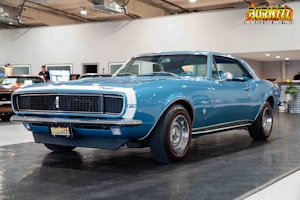Media | Articles
Winning a Woodward drag race in the world’s worst Ford GT
It’s never a good idea to peak too soon. This 2017 Ford GT (serial H984) was once a superstar, sneering at the world from the pages of the Los Angeles Times and sitting patiently in front of a camera, while John Davis told MotorWeek viewers about the “bold decision to just name your car… GT.” It ran the canyons with The Smoking Tire’s Matt Farah and provided brief, if occasionally terrifying, moments behind the wheel to dozens of journalists and VIPs.
That was then—and this is now. H984 doesn’t attract much attention on Woodward Avenue, at least not while it’s parked. All the eyes of passing drivers slide effortlessly past its muted paint scheme and relative paucity of desirable options to the searing lime-green GT500 parked behind it. The GT is yesterday’s news—the GT500 is tomorrow’s Blue Oval superstar. More importantly, you can actually buy a GT500 in the near future without any applications, any interviews, or any approvals besides the one you’ll need from a bank.
Ironically, the same is now true for the mid-engined GT, early examples of which have escaped Ford’s 24-month contractual embrace and are now set to cross the block at various auctions. Estimates for these early cars, many of which have $30,000 or even $50,000 worth of equipment above and beyond H984’s modest option loadout, are in the $1.5M range—stout money for something that is basically an American take on the McLaren MP4-12C. Should you do it, dear reader? Should you spend used-Veyron money on a used GT?
To help us help you make that decision, Ford permitted your humble author to drive a few Woodward Avenue miles in ol’ H984 and see how it’s holding up. This car now has over 12,000 miles on it, most of them in the hands of bumbling autowriters and “influencers” who had never owned a supercar and who were eager to abuse the thing as much as possible. Yes, it’s had first-rate care from the Ford Performance team, but there’s only so much you can do to obscure the effects of wear and tear.
If you remember all those early GT reviews, you already know the basic facts: massive dihedral doors, narrow seats placed close together, plenty of exposed carbon fiber. This also describes a modern McLaren, but the Ford is just more so. The doors, in particular, are much less convenient than their British counterparts. If you’re part of the big-and-tall crowd, you will want to face away from the car and kind of fall backwards into the seats. Which, by the way, are fixed in place. The steering wheel and pedals move. The EcoBoost six fires up with much less drama than what you get from a Ferrari 488 or even a Ford GT350, and with a press of the steering wheel-mounted turn signal I’m on the move.
Marketplace
Buy and sell classics with confidence
When the Times drove the GT, its writer complained that “Slow-speed driving is a nightmare. This two-door coupe couldn’t possibly feel more awkward crawling through city traffic, creeping over speed bumps, or using the small backup camera to parallel park.Under 30 miles per hour, the transmission jerks through the shift points. It’s so clunky on downshifts that I was afraid I was leaving gearbox parts on the road behind me.”

After 12,000 miles, H984 does produce the occasional bang-clunk from the transaxle—but compared to any McLaren or even a Nissan GT-R, it’s pretty benign. I’m actually impressed with how well Ford controls the noise and vibration in the cockpit. It’s closer to a 650S or a Ferrari 488GTB than it is to a 675LT or 458 Speciale in that regard.
If there are any shiny spots or wear areas on the seats or interior, they’ve been refreshed. This looks and feels like a brand-new car. Even the matte-finish carbon fiber has held up. The steering wheel appears to have a tiny bit of sun fade, but the overall durability of the cockpit is more Audi A8 than Viper ACR.
Changing lanes and navigating traffic is surprisingly easy. If you can live with a Corvette Z06 on the road, you can live with a Ford GT—assuming, of course, you can get into the car to begin with. The instrument panel and center screen both fade out in direct sunlight, of which there is a surprising amount given the relatively small glass area.
Left in automatic, the transmission will relentlessly shift up until you’re cruising in fifth or sixth at 30 mph. In this situation, the GT doesn’t feel fast, which probably makes the buyers furious. You can always pull the skeletonized shift paddle, which turns with the steering wheel as God intended, and hustle a bit. In that situation, straight-line thrust is better than a Ferrari 458’s but worse than what you get from a 488.
The rotary mode controller on the wheel can be twisted into track mode, at which point the car drops to the ground with a worrisome clunk. Some people have a fetish for running “track mode” on the street in their Mustangs and Ferraris; doing that in the GT will cost you a front bumper in very short order. In fact, I’d be worried about using “track mode” at Nelson Ledges, and I can think of a few places at the Nürburgring where you’d have to stay off the curbs or hear some expensive noises.
There’s really not much to dislike about ol’ H984, although I can’t imagine any private buyer going for this almost invisible paint scheme, and you’d be silly not to get the carbon-fiber wheels if you had the choice. I’ve driven 12,000-mile Mercedes-AMGs that felt significantly ropier than this hard-driven, hand-built Ford. You could credit the carbon-fiber tub, which should retain more or less identical flex and vibration characteristics throughout its lifetime, but the modern McLarens boast a similar construction and they often feel beat-up-from-the-feet-up before they even leave press fleets. What’s the GT’s secret? It could be that regular maintenance from the factory, or it could be the fact that little to no expense was spared during its construction. No corners were cut.
Well, maybe one corner was cut. The infamous 3.5-liter EcoBoost V-6 shares most of its hard parts with the one in the current F-150, and is not that different from what I have in my 2018 Lincoln MKT. You can look at it as a bold statement of Ford’s confidence in its everyday engines, or you can bemoan it as a commodity component dropped into an otherwise completely bespoke automobile. The market doesn’t seem to mind, although I suspect the aftermarket tuners who did such tremendous things with this car’s V-8 predecessor are unhappy.
The V-6 thing was on my mind as I spotted a ’96 Thunderbird LX ahead of me on the road. It was packed with teenagers enjoying the sights and sounds of the pre-Dream Cruise weekdays. I zipped up next to them at a stoplight.

“V-6 or mod motor?” I yelled. It took the driver a minute to process the fact that:
- There was a Ford GT next to him
- The driver was yelling
- The driver was yelling at him
- And the topic under discussion was his T-Bird.
“Uh… V-6!” he responded.
“SAME HERE!” I bellowed. The cross-street light turned yellow. “SO… “ the light turned red. “LET’S GO!”
When we got the green, I let the GT have full throttle. The launch was head-snappingly strong, perfectly managed by the TC. At each shift, into second then into third, the back end snaked a bit, just enough to let me know that there were serious forces at work. I laid off and waited for the ’Bird to catch up, which took a while. They were laughing. I was laughing. A group of Corvette owners in lawn chairs by the side of the road offered a baseball-stadium wave of rueful but respectful nods.
H984 isn’t on the covers of magazines any more. You could pick a more compelling or iconic color scheme by throwing darts at a Home Depot paint wall. Since it’s an early-production car, It doesn’t have a clear title, and even if it did, Ford would be unlikely to allow it onto an auction stage anywhere. It has more miles than the vast majority of GTs in private hands—“We know of at least one with more than 35K,” according to my Ford source, “but in general, they aren’t being driven much.” And it’s been shoved out of the spotlight by everything from the new C8 Corvette to Ford’s own twisted-to-11 GT Mark II. Not to worry. Judging by the way it rushes through the gears, and the childlike joy it generates in the Woodward crowd, I’m not sure this particular Ford GT has peaked quite yet.










